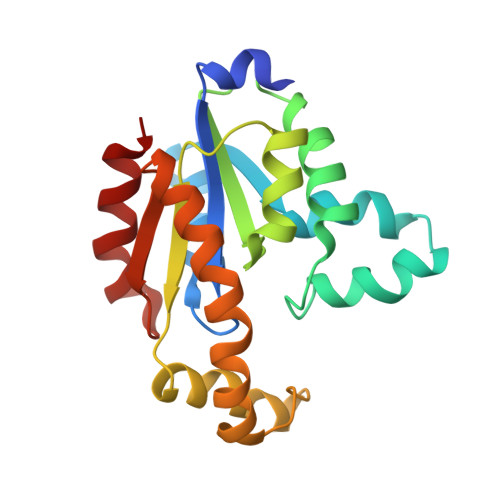ADP-Induced Conformational Transition of Human Adenylate Kinase 1 Is Triggered by Suppressing Internal Motion of alpha 3 alpha 4 and alpha 7 alpha 8 Fragments on the ps-ns Timescale.
Guo, C., Zhang, H., Lin, W., Chen, H., Chang, T., Wu, Z., Yu, J., Lin, D.(2022) Biomolecules 12
- PubMed: 35625598
- DOI: https://doi.org/10.3390/biom12050671
- Primary Citation of Related Structures:
7X7S - PubMed Abstract:
Human adenylate kinase 1 ( h AK1) plays a vital role in the energetic and metabolic regulation of cell life, and impaired functions of h AK1 are closely associated with many diseases. In the presence of Mg 2+ ions, h AK1 in vivo can catalyze two ADP molecules into one ATP and one AMP molecule, activating the downstream AMP signaling. The ADP-binding also initiates AK1 transition from an open conformation to a closed conformation. However, how substrate binding triggers the conformational transition of h AK1 is still unclear, and the underlying molecular mechanisms remain elusive. Herein, we determined the solution structure of apo- h AK1 and its key residues for catalyzing ADP, and characterized backbone dynamics characteristics of apo- h AK1 and h AK1-Mg 2+ -ADP complex (holo- h AK1) using NMR relaxation experiments. We found that ADP was primarily bound to a cavity surrounded by the LID, NMP, and CORE domains of h AK1, and identified several critical residues for h AK1 catalyzing ADP including G16, G18, G20, G22, T39, G40, R44, V67, D93, G94, D140, and D141. Furthermore, we found that apo- h AK1 adopts an open conformation with significant ps-ns internal mobility, and Mg 2+ -ADP binding triggered conformational transition of h AK1 by suppressing the ps-ns internal motions of α 3 α 4 in the NMP domain and α 7 α 8 in the LID domain. Both α 3 α 4 and α 7 α 8 fragments became more rigid so as to fix the substrate, while the catalyzing center of h AK1 experiences promoted µs-ms conformational exchange, potentially facilitating catalysis reaction and conformational transition. Our results provide the structural basis of h AK1 catalyzing ADP into ATP and AMP, and disclose the driving force that triggers the conformational transition of h AK1, which will deepen understanding of the molecular mechanisms of h AK1 functions.
- Key Laboratory of Chemical Biology of Fujian Province, College of Chemistry and Chemical Engineering, Xiamen University, Xiamen 361005, China.
Organizational Affiliation:
















